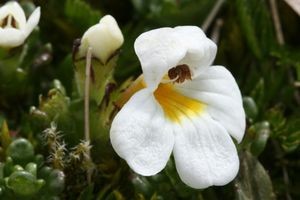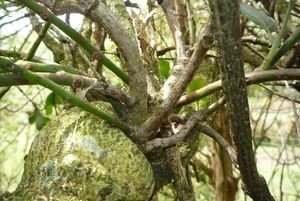 Root parasite Euphrasia revoluta. Photo: Mike Thorsen.Parasitic plants belong to about 19 families of flowering plants. The Viscaceous and Loranthaceous mistletoes comprise approximately three-quarters of all parasitic species. Several other families of parasitic flowering plants are also well known, especially the broomrapes (Orobanchaceae) and dodders (Cuscutaceae).
Root parasite Euphrasia revoluta. Photo: Mike Thorsen.Parasitic plants belong to about 19 families of flowering plants. The Viscaceous and Loranthaceous mistletoes comprise approximately three-quarters of all parasitic species. Several other families of parasitic flowering plants are also well known, especially the broomrapes (Orobanchaceae) and dodders (Cuscutaceae).
Parasitic plants have a modified root called the haustorium which penetrates the host plant and connects to the host’s xylem and/or phloem.
 Ileostylus micranthus attached to a Coprosma proquinqua. Photo: Jesse BythellThere are a number of terms associated with parasitism:
Ileostylus micranthus attached to a Coprosma proquinqua. Photo: Jesse BythellThere are a number of terms associated with parasitism:
- Root parasite: attaches to the host root.
- Holoparasite: completely parasitic on other plants and has virtually no chlorophyll.
- Hemi-parasite: parasitic but also photosynthesises itself. Obtains water and mineral nutrients and may obtain part of its organic nutrients from the host.
- Obligate parasites: cannot complete its life cycle without a host.
- Facultative parasite: can complete its life cycle independent of a host.
- Stem parasite: attaches to the host stem.
For more information see:
- Parasitic plant (Wikipedia)
- Plant pirates - some NZ parasitic plants by Miriam A. Aiken
- The Parasitic Plant Connection
- The Mistletoe Centre (US Forest Service)
- Parasitic Plants (UCLA)
- Parasitic Plants (Botanical Society of America)
- The International Parasitic Plant Society
